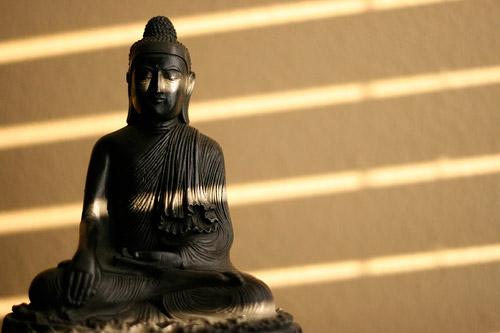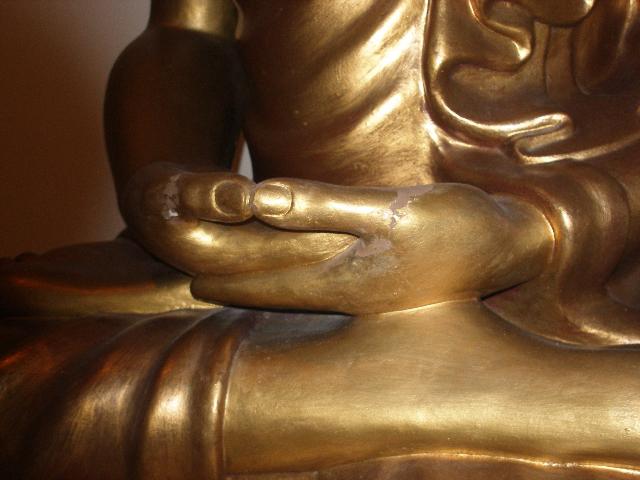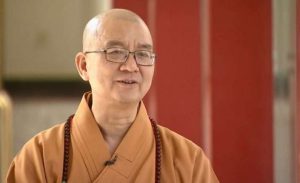
The practice of mindful meditation can provide a great host of benefits to anyone that actively pursues it, especially in a modern world full of enhanced stresses and defilements that so often remove people from a more natural state of peace and tranquility. There are many different meditative practices that can be carried out to calm the mind which are becoming more highly recognised around the modern world, particularly within the West, for having such useful, and often immediate, effects. In many cases today, “[m]editation is being taught to help people obtain release, not from the cycle of birth and death, but from the strains of financial pressures, psychological disorders, and stressful relationships” (Bodhi, 2011:35).
The two main categories of meditation are samatha-bhavana, to bring mental tranquility and temporarily suppress/block mental defilements, and vipsanna-bhavana, to gain wisdom and understanding in order to liberate the mind from mental defilements. The Four Foundations of Mindfulness draw on both forms of meditation in order to ultimately liberate the mind from suffering through the endless cycle of samsara, by attaining enlightenment and achieving nirvana.

The Four Foundations are held under the ‘Concentration/Meditation’ (Samatha) division of the Noble Eightfold Path under ‘Right Mindfulness’ and is carried out once a firm grasp of moral/ethical conduct (sila) has been attained (1). The Supreme Buddha explains that following the Four Foundations of Mindfulness is, “[t]he only way that leads to the attainment of purity, to the overcoming of sorrow and lamentation, to the end of pain and grief, to the entering upon the right path and the realization of Nibbana […]” (Nyantiloka, 1967:58). It begins with the contemplation of the physical body, subsequently moving onto the mental contemplation of feelings and then the mental states/consciousnesses, ending with the contemplation of both the physical and mental phenomena of the dhammas. The overall aim is to gain the wisdom to achieve the realisation of truth and to accept it as being true in order to become as fully enlightened and liberated as the Supreme Buddha himself. Achieving the realisation of truth is to comprehend the concepts of suffering, impermanence and non-self.
Within each foundation, the meditator must remain mindfully aware of a specific object of contemplation, focusing all concentration towards that alone in order to become fully aware of its presence and effects. They must repeatedly think or say aloud the thing in which they are focusing their attention towards, along with any observations made about it, throughout the practice. In doing so, they can work their way through the jhanas to attain a level of one-pointedness concentration. At such a level, all other distractions and hindrances are relinquished so that only their object of contemplation is conceivable. Though still aware of their surroundings, they envelop into such a deep trance-like state of meditative concentration that nothing can unwillingly disturb or distract them.
The first foundation along the path is the contemplation of the body in the body. The Buddha explains how to contemplate this in fourteen different ways, that is, fourteen different objects of contemplation to focus on in order for the meditator to become fully aware of the physical ‘self’ and overthrow any attachments towards it (2). Through mindful contemplation, the meditator can eventually come to see the suffering the body must naturally go through. Just as the Buddha observed through his renowned ‘Four Encounters’, the meditator will be able to realise that the body ages, succumbs to illness and eventually dies. The body is made up of repulsive constituents that should also be observed and noted in order to liberate the innate urge to cling to it, that is, to want the body to somehow be ‘you’. By observing the body as repulsive, aging and suffering as it slowly decays to nothingness, you come to see it as just a body. There is no agent that that body belongs to or is part of. No part of that body can be called the self; it is just physical matter that is impermanent, with nothing to attach itself to. Though not all fourteen topics need to be mindfully contemplated upon in order to sufficiently understand this, they are all relevant towards achieving the realisation of truth in there own way. Whereas some ways may be easier for the meditator to contemplate upon, others may have more of an effect.
These fourteen topics of contemplation start with being mindfully aware of breathing in/out of the body. This is the most well-known and practiced contemplation of the body as it is carried out through the samatha meditation of anapanasati. This is the practice most people typically imagine when first hearing ‘meditation’ and is frequently used independently as a technique to relax the mind from mental defilements. Though anapanasati is not a necessary practice for the start of mental purification, it often serves as a root foundation on which to develop the mind further, as it is here. The Buddha himself is thought to have often practised anapanasati, “[…] throughout the years during his solitary retreats, and constantly recommended it to the monks, praising it as, ‘peaceful and sublime, an unadulterated blissful abiding, which banishes at once and stills evil unwholesome thoughts as soon as they arise’” (Bodhi, 1994:84).
In practicing anapanasati, the meditator must focus all concentration on breathing. They must note each breath as it happens, along with any detail that makes that breath different, being mindfully aware of the air passing through the nostrils and around the body. For every breath in, one must note, “breath in”, for every long breath out one must note, “long breath out” and so on. In doing so, the mind can keep focussing solely on breathing and the physical body, without other distracting thoughts interfering. Continuing with this, the meditator can come to see the body as just physical matter, a shell in which the mind is held and must be liberated from through mindful wisdom (3).
This same mindful concentration can also be applied to the posture of the body, to contemplate the mindful movements of the body upon request. When moving forward, it must be noted, ‘moving forwards’, reflecting on each movement/step. There is also the reflection upon the repulsiveness of the 32 parts of the body and its make-up consisting of the four material elements (Earth, Water, Wind and Fire) and being mindful with clear comprehension through the five mental faculties. The last is contemplation on the nine stages of cemetery practice, observing the breakdown of a corpse and how flesh decays to nothing but lifeless, material bone.
This same technique is then used to practice the second foundation of contemplating mental feelings. There are three broad categories of feelings that rise and fade within people. These are positive, negative and neutral. Positive feelings are those such as joy, happiness and general pleasures. Negative feelings bring anger, sadness and general displeasure. Neutral feelings are those that are neither positive nor negative towards an object or thought, yet cannot be let go off. We often have neutral feelings towards the physical money we carry. While people may value the figure on the screen of the ATM and what that is worth within the modern world, the physical paper itself means nothing to them above another. Yet they cling to it. This is a worldly-neutral feeling of delusion and should be noted when it arises.
When practicing vipsanna meditation and contemplating feelings, the meditator learns to simply observe the feelings as being feelings that rise/fade rather then being ‘attached’ to them as personal feelings that are permanent within themselves/others. Instead, just as a scientist observes the reactions of chemicals, only noting the formula changing, the meditator must step back, out of themselves, and observe feelings rising/fading. Like the scientist, they must only take note of them by thinking, ‘this is an angry feeling’ or, ‘this is a happiness feeling’ repeatedly as they occur. By observing them in this way, it becomes possible to detach from the notion of being and ‘self’. There are just feelings that rise and fade with no agent to which they are part of. They exist for themselves rather then for an individual person.
Furthermore, the meditator is able to observe how feelings are never long lasting. With every moment the feeling of pain becomes less intense as it gets replaced by another new feeling of pain until it eventually fades altogether. When experiencing pain, or similar sensations, it is important to note that there is a painful, unpleasant feeling, not a continuous stream of ‘pain’. Such feelings cause suffering, are impermanent and cannot attach to a self. In observing and noting them, the urge to cling to them fades and the meditator comes ever closer to achieving the realisation of truth.
The third foundation applies the same technique to contemplate and be mindful of inner mental factors and consciousnesses. When conscious of an object, mental factors are what cause the reaction or feeling towards them. Mental factors are inseparable from consciousness but are more then just feelings in that they can be thoughts towards/about things consciously. Greed, faith and wisdom, as well as hatred and anger, are all mental states, despite potentially incorporating positive, negative or neutral feelings. The meditator must be mindfully aware of these rising/fading consciousnesses. Every time hatred arises it must be noted by saying/thinking ‘hatred, hatred, hatred’, or whatever the consciousness may be. Having the mental factor of hatred in your mind means you have a consciousness of hate towards a particular object of focus (mental or physical). There are many different types of consciousness, all of which are described within the Abhidhamma, but these are not necessary to know by name. All that matters when contemplating consciousness is that the meditator remains ever mindfully aware of them rising and fading within the mind.
By observing mental factors and consciousnesses rise/fall in this way, the meditator learns that there is only consciousness, with no being as its agent. They are not permanent; each rises and fades away continuously being replaced by another. Because of this impermanence, there is no desire to cling to them through wrong view or craving. Without this, there is no formation of karma and so they become liberated from suffering (Ven.Silananda, 2002:88)
The final foundation is the contemplation of both the mental and physical phenomena of the dhammas. The first subsection contemplates the five hindrances. These are the mental obstacles that hinder focussed concentration. They arise in the form of sense-desire, ill will, sloth and torpor, restlessness and remorse and doubt. When attempting to focus all attention on one thing, for example breathing in/out, it is one of these that arise to suppress and distract focussed thoughts, often without any stimulus or reasoning for it to enter the mind at all. One must observe these hindrances rising and fading, being aware of the origination and dissolution factors of them in order to prevent them arising again in future meditations.
The next area within the dhamma contemplates the five aggregates of clinging. These are the aggregates of matter, feelings, perception, mental formations and consciousness. Through the previous three foundations, matter, feelings and mental formations and consciousness have already been heavily contemplated upon and by this stage should have already been detached from. Perception is how we see the world through our senses, which can often be wrong allowing us to interpret the world falsely. Experiencing déjà vu or seeing the world through rose-tinted glasses creates experiences that we see differently to true reality. As a result, Buddhism teaches people to not fully rely on perceptions alone to understand the world. At this stage the aggregates are not looked at in such specific detail, but as broad concepts that rise and fade as a whole with nothing to attach to.
Next come the six internal and six external sense bases to be contemplated upon. These are the internal sense-bases of the eyes, ears, nose, tongue, body and mind along with their corresponding external stimuli. There are then the seven factors of enlightenment: Mindfulness, Investigation, Energy, Joy, Tranquillity, Concentration and Equanimity. Each of these are contemplated on and applied to meditative concentration in order to gain the wisdom to understand enlightenment.
The final subsection to be contemplated is that of the Four Noble Truths, discovered by the Noble Buddha. This is a large stage that requires mindful knowledge of the Buddhist concepts of these truths. It begins with the Noble Truth of suffering, followed by the origins of such suffering, the cessation of suffering and the Noble Eightfold Path as a whole. Through actively meditating mindfully on these truths the meditator comes to finally gain the wisdom to fully accept the realisation of truth as being true and immediately attains enlightenment in a state of true nirvana.
In practicing the Four Foundations of Mindfulness, one is able to attain the ultimate aim of Buddhism: to gain enlightenment and achieve nirvana, being liberated from suffering within the cycle of samsara. Though I have laid it out in a simplistic, easy to use, systematic path here, it is by no means an easy feat to undergo. “People who practiced meditation in their past life, and so have accumulated experience, can attain [enlightenment] in a short time, but people who don’t have such experiences need much longer to reach enlightenment” (Ven. Silananda, 2008:168). As we know through the famous jataka stories, it took the Buddha many previous lifetimes before he was noble enough to undergo the full Noble Eightfold Path and achieve Buddhahood. However, the Buddha had to re-discover the path to enlightenment for himself, whereas for some that were taught directly it took far less time. The Buddha claimed it would take up to seven years of dedicated mindful meditation following the Four Foundations of Mindfulness to achieve and accept the realisation of truth, but for some it could take less then a week. An example of which is Subhadda, the former ascetic who doubted the Buddha’s teachings. He visited the Buddha only hours before his parinirvana and was quickly convinced by his teachings. He was taught the ways of the Noble Eightfold Path, including the Four Foundations of Mindfulness, and achieved the highest level of sainthood by the next morning as the last disciple of the Buddha (Ven. Silananda, 2008:165-171).
This is of course a rare case but shows that everybody can attain enlightenment by following the middle way. Though, many may not be mentally ready or confident enough to undergo such a path during their current lives, and this is not a problem. Even practicing basic samatha meditations can help to bring a more beneficial current life and cultivate the mind ready for the next. Buddha Siddhartha said near the end of his life that his teachings of the dharma should be used by all and for people to take what they need from it (Bodhi, 2011:35-36). If people do not need/want to practice vipsanna meditation to be liberated in this life then this is perfectly acceptable as everyone can gain benefits from any amount of Buddhist mindful practice.
It is believed that the Buddha taught the Four Foundations of Mindfulness primarily to the Kuru people, near what is now New Delhi. Though he did not limit his teachings to here alone, the Kurus were gifted with comforts such as the perfect climate and good food and drink that made them happy in both body and mind. Their physically and mentally fit states allowed them to develop greater wisdom and so more easily accept the profound teachings of the Buddha. Ven. Silananda believes that in the modern world, the people of the West are now in the most comfortable conditions. They have controlled indoor climates with air conditioning/heaters and rich food and drink from around the world that can be delivered to their doors. For this reason, he believes they live in the most comfort and are the happiest in body and mind, making them wise enough to be able to accept the teachings of the Four Foundations of Mindfulness the easiest (Ven. Silananda, 2008:168-171).
However, I do not agree with this idea. The modern Western world seems to be the most defiled, with greed and hatred at the source of their society. It is so engrained into their daily life that the habit to think and live under such defilements overpowers the concentration and focus that is needed in order to successfully attain enlightenment. Though there are many that may be happier and wiser as a result of a healthy mind and body living comfortably in the West, the majority unfortunately seems too corrupt and ignorant to properly conceive of the realisation of truth at this time. However, mindful meditation is becoming more popular within the Western world today, so perhaps this may spark a more spiritual and calm side of people that has been lacking within the past few centuries. This can be done through the active practice of mindful meditation, following the Four Foundations of Mindfulness for the benefit of all sentient beings.
(1) The Noble Eightfold Path is of central importance within Buddhist meditation and philosophy. Though it does not necessarily have a set order in which to follow/practice, it is easiest to describe it as one division following on from the other; Moral/ethical conduct (sila) to concentration/meditation (samatha) and finally to wisdom (vipsanna), each of which hold several steps within them. There is plenty of literature on the Noble Eightfold Path that gives more detail then I do within this paper, which is very useful to read before practicing Buddhist meditation under the Four Foundations of Mindfulness.
(2) In achieving the realisation of truth, one must accept the concept of non-self; that there is no permanent ‘self’ that extends beyond the physical body, of which is itself impermanent with new cells replacing older ones constantly until it decays to nothingness, with all the energy that formed ‘you’ being put back into the universe for rebirth/change. The concept of non-self is very difficult to contemplate but very important to grasp in order to fully understand Buddhist philosophy.
(3)Asceticism to liberate the mind is not successful, as the Buddha taught after personal experience of starving himself from food and water in an attempt to free his mind from his body earlier in his spiritual years. Though, he quickly learnt that this only stops the mind from being able to sufficiently concentrate on mindful meditation and reach liberated enlightenment.
References
Bodhi, Bhikkhu. ‘The Noble Eightfold Path: The Way to the End of Suffering’ (Kandy: Buddhist Publication Society, 1994)
Bodhi, Bhikkhu. “What Does Mindfulness Really mean? A Canonical Perspective”, Contemporary Buddhism 12:01 (2011) pp.19-39
Nyanatiloka, Bhikku. ‘The Word of the Buddha: An Outline of the Teaching of the Buddha in the Words of the Pali Canon’ (Ceylon: Buddhist Publication Society, 1967)
Ven. Sayadaw, Ledi. ‘The Noble Eightfold Path and its Factors Explained’ (Kandy: Buddhist Publication Society, 1998)
Ven. Silananda, U. ‘The Four Foundations of Mindfulness’ (Boston: Wisdom Publications, 2002)
Thera, Nyanasatta. ‘The Foundations of Mindfulness: Satipatthana Sutta’ (Access to Insight, 7th June 2010)
http://www.accesstoinsight.org/lib/authors/nyanasatta/wheel019.html [Accessed on 24th December 2012]











